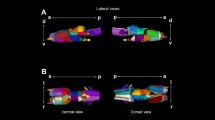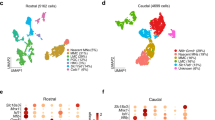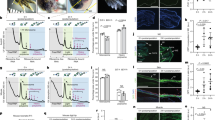Abstract
DENERVATION of the limb of a lower vertebrate is followed by an ordered reinnervation, so that the normal pattern of muscle use is restored1. Higher vertebrates, however, seem to be much less selective in their reinnervation2. There is no absolute restriction on inappropriate reinnervation in lower vertebrates3; the return of normal function is due, at least in part, to multiple reinnervation of muscle fibres by different nerves, followed by a repression of function of less appropriate contacts4. Yip and Dennis5 have shown that the repression of function in inappropriate nerve-muscle junctions in the newt, Notopthalmus viridescens, involves a reduction in the number of quanta of synaptic transmitter released by each nerve impulse. If the initiating event in this process is reduction or loss of the ability of inappropriate nerve terminals to release transmitter6,7, there should be evidence of the continued presence of these terminals even after transmission from the inappropriate nerve has been repressed. In this paper we present such evidence as a result of our studies in the axolotl.
This is a preview of subscription content, access via your institution
Access options
Subscribe to this journal
Receive 51 print issues and online access
$199.00 per year
only $3.90 per issue
Buy this article
- Purchase on SpringerLink
- Instant access to full article PDF
Prices may be subject to local taxes which are calculated during checkout
Similar content being viewed by others
References
Grimm, L. M. J. exp. Zool. 178, 479–496 (1971).
Frank, E., Jansen, J. K. S., Lomo, T. & Westgaard, R. H. J. Physiol., Lond. 247, 725–743 (1975).
Frank, E. & Jansen, J. K. S. J. Neurophysiol. 39, 84–90 (1976).
Mark, R. F. Expl Neural. 12, 292–302 (1965).
Yip, J. W. & Dennis, M. J. Nature 260, 350–352 (1976).
Cass, D. T., Sutton, T. J. & Mark, R. F. Nature 243, 201–203 (1973).
Marotte, L. R. & Mark, R. F. Brain Res. 19, 41–51 (1970); 46, 131–148 (1972).
Genat, B. R. & Mark, R. F. Proc. R. Soc. (in the press).
Harris, A. J. & Miledi, R. J. Physiol., Lond. 221, 207–226 (1971).
Dennis, M. J. & Miledi, R. J. Physiol., Lond. 239, 553–570 (1974).
Birks, R., Katz, B. & Miledi, R. J. Physiol., Lond. 150, 145–168 (1960).
Heuser, J. & Miledi, R. Proc. R. Soc. B 179, 247–260 (1971).
Miledi, R. J. Physiol., Lond. 154, 190–205 (1960).
Hubbard, J. I., Jones, S. F. & Landau, E. M. J. Physiol., Lond. 197, 639–657 (1968).
Harris, A. J. & Miledi, R. J. Physiol., Lond. 217, 497–515 (1971).
Del Castillo, J. & Katz, B. J. Physiol., Lond. 124, 553–559 (1954).
Katz, B. & Miledi, R. J. Physiol.,Lond. 203, 689–706 (1969); 216, 503–512 (1971).
Cull-Candy, S. G., Lundh, H. & Thesleff, S. J. Physiol., Lond. 260, 177–203 (1976).
Author information
Authors and Affiliations
Rights and permissions
About this article
Cite this article
HARRIS, A., ZISKIND, L. & WIGSTON, D. Spontaneous release of transmitter from ‘repressed’ nerve terminals in axolotl muscle. Nature 268, 265–267 (1977). https://doi.org/10.1038/268265a0
Received:
Accepted:
Issue date:
DOI: https://doi.org/10.1038/268265a0



